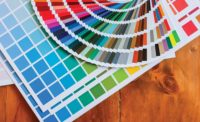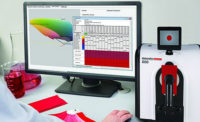When white light strikes a surface, two different light interactions occur. Gloss or shininess is a geometric attribute related to the scattering of light off the first surface of the material. Color is a chromatic attribute related to the absorption of light by the colorant in the material.
When we describe the “color” of a material, we speak in chromatic terms such as lightness saturation and hue.
When we speak of “color and appearance,” additional geometric terms related to gloss or shininess are added to our description.
When light strikes an opaque object (Figure 1), the light interaction is characterized at the surface as a specular reflection for gloss/shininess and diffuse reflection for color.
Specular reflection is light that is directed at an angle equal but opposite to the incident light and is perceived by a human observer as glare caused by the shininess or glossiness of the sample. To see the apparent color of the sample, observers must move their eyes away from the glare specular reflection and concentrate on examining the diffuse (scattered) reflectance from the sample. These viewing conditions have led to standardized industrial methods for visual evaluation such as ASTM D1729 “Standard Practice for Evaluation of Color Differences of Opaque Materials.”
When the smoothness of a surface changes resulting in higher micro-roughness and lower gloss, the light-reflection characteristics from that surface become more complex. As shown for a medium-gloss sample in Figure 2, the specular reflectance is spread by the micro-roughness and becomes mixed with the diffuse reflected light. A matte surface having higher micro-roughness scatters almost all the white specular light, which mixes with the normally scattered diffuse reflectance, causing the perceived color to appear lighter and less saturated.
Color appearance is affected by the roughness of the surface independent of the color. To the average observer, a high-gloss specimen would appear to be more chromatic or colorful and darker than an identically pigmented specimen with lower gloss or increased surface micro-roughness.
Instrument Types
There are basically four geometries for color-measuring instruments:
- Diffuse d/8° Sphere, specular reflectance included
- Diffuse d/8° Sphere, specular reflectance excluded
- Directional 45°/0° (specular excluded)
- Directional 0°/45° (specular excluded)
Diffuse Sphere, Specular-Included
The integrating sphere geometry, which is most commonly the diffuse d/8° design, provides diffuse spherical illumination and 8° viewing conditions. When a diffuse sphere instrument is used to measure samples in the RSIN reflectance specular included mode, the sphere tends to negate the slight differences in surface roughness shown in Figure 2 and provides consistent color measurement.
Sphere-Based, Specular-Excluded
Some sphere instruments can also be operated in a specular-excluded mode. The measurement is accomplished by opening a port on the sphere wall that allows the specular component of reflected light to be excluded from the measurement. Due to the nature of the design of sphere instruments, the size of the specular-excluded port is limited. When measuring smooth, high-gloss surfaces, the specular component can be completely excluded as all specular light passes through the port. However, when measuring medium-gloss, low-gloss or textured specimens, the specular reflectance spreads over an angle greater than what can be completely excluded by the port opening. This presents a limitation in the ability of a diffuse sphere instrument to completely exclude all of the specular reflectance for all sample types.
Directional 45°/0° or 0°/45°
When a human visually evaluates a sample, they avoid the specular gloss component and evaluate the diffuse reflectance which is sensitive to changes in colorant or surface characteristics.
Directional 45°/0° or 0°/45° geometry instruments best match human visual evaluation of opaque samples. They are most often used in quality-control applications where the overall color appearance and batch-to-batch consistency of the product is most important. A directional 45°/0° or 0°/45° instrument is very sensitive to a change in any of the parameters of appearance and will alert the user that a visual difference exists.
Which geometry is best?
Although determining the most appropriate instrument depends on the application, two general rules apply. To negate the effects of surface characteristics, such as gloss, texture and pattern, and simply measure color, use a sphere-based instrument in the specular-included mode. To measure based on colorant and surface characteristics, use a directional 45°/0° or 0°/45° instrument.
References
ASTM E179 Guide for Selection of Geometric Conditions for Measurement of Reflection and Transmission.
ASTM E1767 Standard Practice for Specifying the Geometry of Observations and Measurements to Characterize the Appearance of Materials.
|
TECH TIPS
|





